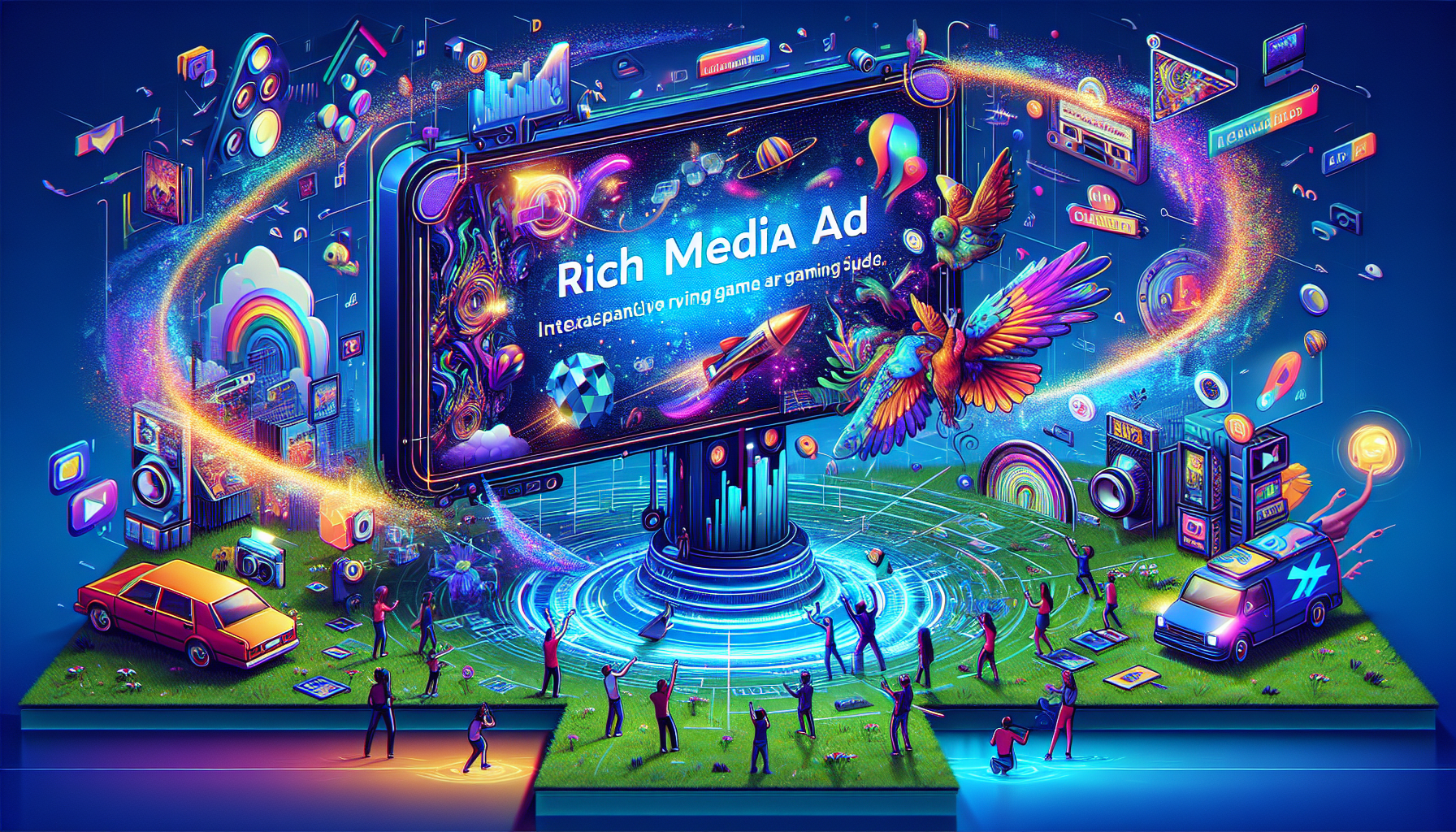In-game advertising offers a route to engage the vast gaming audience; but success hinges on the right strategy. This concise overview dives into the most impactful ad formats and strategies that drive engagement and growth for your brand. You’ll get practical tips and industry examples that translate virtual in-game experiences into tangible brand benefits.
Key Takeaways
- In-game advertising capitalizes on the expanding mobile gaming market, offering a variety of ad formats like banner ads, native ads, and interactive playable ads to engage a wide and diverse audience, with substantial projected market growth by 2027.
- Creating effective in-game ad campaigns requires balancing creativity with non-intrusiveness, targeting a diverse audience, and measuring success with KPIs such as eCPM, IPM, and user engagement to ensure ad recall and brand loyalty.
- In-game advertising is being revolutionized by technological advancements such as real-time ad insertion, AR/VR ads, and data-driven personalization, posing challenges surrounding user privacy and platform evolution and predicting significant industry growth.
Unlocking the Potential of In-Game Advertising

In-game advertising, an innovation in marketing, taps into the broad audience and high engagement of mobile games to bolster ad budget and brand visibility. This form of advertising is not only cost-effective but also offers an array of ad formats for brands to explore, including banner ads, native ads, and interactive playable ads.
As mobile phone ownership extends to more than half of the global population, the potential audience for in-game advertising expands, providing brands an exciting opportunity to:
- Amplify their mobile ad campaigns
- Reach a wider audience
- Increase brand visibility
- Engage with consumers in a unique and interactive way
The Rise of In-Game Ad Spend
The growing in-game advertising market highlights its escalating importance to brands. Some key statistics include:
- The U.S. in-game advertising market alone is expected to reach $42.57 billion by 2024.
- The global ad spend is projected to hit a staggering $58.52 billion by 2027.
- Worldwide mobile ad spend has already surpassed $327.1 billion.
This growth demonstrates the significant potential for brands to reach their target audience through in-game advertising.
These figures suggest a bright future for in-game advertising, drawing an increasing number of non-endemic brands eager to engage with the extensive and varied gaming audience.
Types of In-Game Ads

In-game ads are available in various forms, tailored to cater to diverse gaming experiences and audiences. Gamers often prefer intrinsically integrated ads like virtual billboards, which add realism to the game without disrupting gameplay. Native ads, designed to blend seamlessly with the game environment, are another popular choice.
Mobile banner ads and full-screen interstitial ads are two types of mobile ads that are common, designed to be noticed but not to interrupt the flow of the game. The diversity of these ad formats offers brands ample flexibility in crafting their in-game advertising strategies.
Engaging Gamers Through Playable Ads

Playable ads have surfaced as a distinctive and engaging form of in-game advertising. These ads provide users with a sneak peek of a mobile app, offering a bite-sized taste of the advertised app experience. By making users feel like they are playing a game, playable ads extend the engagement period of mobile advertisement, enhancing interaction and brand recall.
Examples of successful mobile advertising examples, such as McDonald’s rich-media interactive ad unit for its campaign, significantly boosted user interaction and brand engagement. Brands can leverage playable ads other mobile devices to drive users towards a call to action, such as making a purchase or subscribing to a service, leading to better conversion rates.
Crafting Effective In-Game Ad Campaigns

To create a successful in-game ad campaign, one must have a clear and measurable goal, a comprehensive understanding of the target audience, and an effective way to evaluate success using relevant KPIs. As the market evolves, staying ahead of new technologies in digital marketing and being open to experimentation is crucial.
The right partner can enable brands to swiftly adapt their in-game advertising strategies to upcoming market shifts, ensuring their campaigns remain relevant and effective.
Balancing Creativity and Intrusiveness
Striking the right balance between creativity and intrusiveness is a key challenge in in-game advertising. Ads must resonate with gamers and respect their culture without patronizing them. Some effective strategies for in-game advertising include:
- Non-disruptive ads that leverage natural gameplay pauses
- Product placement within the game environment
- Sponsored in-game events or challenges
- In-game billboards or signage
However, dynamic in-game advertising methods like interstitial ads can disrupt the user experience if not executed thoughtfully.
Immersive ad experiences such as AR and VR ads require creative strategies to engage gamers effectively. By leveraging data-driven insights for personalized customer journeys, brands can achieve the perfect balance between creativity and intrusiveness, optimizing user engagement and conversions.
Target Audience Considerations
To tailor in-game ad campaigns, it’s crucial to understand the diverse gaming audience. The gaming audience spans genders, ages, and interests, requiring advertisers to go beyond game-related products. Research shows that while young males often gravitate towards hardcore games, more than half of casual gamers are females. This diverse and engaged audience provides opportunities for brands to reach a broad spectrum of consumers through in-game advertising.
Advancements such as real-time data enable iGaming operators to create segmented player profiles, allowing for more tailored advertising strategies.
Measuring Success with Key Performance Indicators (KPIs)
The use of KPIs is vital for gauging the success and profitability of in-game advertising efforts. Key KPIs include:
- Effective cost per mille (eCPM)
- Number of installs per mille (IPM)
- Organic conversion rate
- K-factor
- Daily active users (DAU)
- Monthly active users (MAU)
- App stickiness
- Return on ad spend (ROAS)
- Average revenue per paying user (ARPPU)
- Lifetime value (LTV) of the user
Brands can approach performance measurement through A/B testing, programmatic measurement, and the use of aggregation software or other mobile apps as measurement partners.
Real-world examples from Ben & Jerry’s and Tesco demonstrate how rewarded video ads can increase ad recall and purchase intent, leveraging these KPIs to measure campaign impact.
The Synergy Between Mobile Games and In-App Ads
Mobile games and mobile ads, particularly in-app ads, synergize to craft engaging advertising experiences for gamers. By implementing effective mobile advertising strategies, in-app ads can include dynamic and interactive elements such as animations and mobile video ads to increase engagement. They can also offer incentives like rewarded ads, which encourage user interaction in app ad, albeit with the risk of attracting unqualified traffic.
The significant usage of mobile phones contributes to the growth of marketing spend among smartphone users, making a well-planned mobile advertising strategy essential in reaching fragmented audiences, including mobile users, efficiently through mobile advertising and mobile marketing on mobile devices.
The Dominance of Mobile Device Gaming
The ubiquitous use of mobile devices for gaming has resulted in a diverse audience for in-game advertising, necessitating brands to adapt their strategies. The prevalence of casual mobile games has led to a diverse demographic of gamers from various age groups, reshaping the audience profile for advertisers. Mobile gamers are not limited to the stereotypical young gamers at home; many engage with games during their commutes, expanding the contexts in which mobile games search ads are played.
With the rise of in-game economies, virtual commerce facilitated by in-game advertising has become an essential part of the mobile gaming industry.
Rich Media Ads: A Game Changer

Rich media ads are transforming the landscape of in-game advertising. These ads incorporate diverse multimedia content such as video and audio, creating an immersive experience that captivates gamers. The interactivity in rich media ads, like playable elements or decision points, significantly increases user engagement within mobile games video apps.
As a result of their immersive and interactive qualities, rich media ads have become a game-changing strategy for enhancing brand visibility in the virtual world.
Social Media Integration
The integration of in-game advertising with social media initiatives can stimulate long-term engagement and maintain interest in brand collaborations. Interactive in-game ad formats can lead to immediate social discussion among gamers, enhancing Share of Voice due to the focused ad placements compared to traditional web or social media ads.
The rise of gaming as a popular household activity has been partly fueled by its visibility on various social media platforms, which in turn has amplified the importance and effectiveness of in-game advertising.
Leveraging Technology for Enhanced In-Game Ads
The effectiveness of in-game advertising is being amplified by technological advancements. The use of programmatic advertising offers a foundation for delivering highly personalized ad experiences to gamers. In the metaverse, technological improvements are enabling brands to explore new, highly interactive ad formats.
Machine learning and artificial intelligence are key drivers behind the customization and sophistication of these new programmatic ad experiences.
Real-Time Ad Insertion
Real-time ad insertion facilitates dynamic and contextually relevant ad placements within games, enhancing user experience and ad performance. This technology facilitates the dynamic placement of advertisements within games by analyzing and responding to factors such as user behavior and the in-game context.
Dynamic in-game advertising allows for real-time updates to ad banners within games, providing advertisers the ability to adjust campaigns flexibly and geo-target users based on their location.
Augmented Reality (AR) and Virtual Reality (VR) Ads
AR and VR ads offer immersive advertising experiences, necessitating creative strategies for effective gamer engagement. These ads are poised to enrich the gaming experience with highly immersive product placements, solidifying brand memory. The effectiveness of VR ads can be substantially improved by weaving them into the game’s narrative, making them appear seamless and contextually appropriate.
Strategic VR ad campaigns employ data analysis to ensure that advertising does not become intrusive, thus preserving the gaming experience and promoting a positive brand image.
Data-Driven Personalization
Data-driven personalization empowers brands to provide highly targeted and relevant in-game ads, thereby optimizing user engagement and conversion rates. Some benefits of data-driven personalization include:
- Providing personalized and non-intrusive advertising experiences
- Aligning channels and formats with the audience’s content consumption habits
- Increasing user engagement and conversion rates
For instance, Starbucks uses AI in its mobile app to generate personalized in-app ads and recommendations tailored to a user’s purchasing history and preferences. Data Clean Rooms facilitate the anonymous sharing of user behavior data among advertisers, publishers, app users, and partners, enabling personalized advertising without compromising personal identifiable information.
Brand Partnerships and Sponsorship Opportunities in Gaming
Successful brand partnerships and sponsorships in gaming frequently entail:
- The integration of products or services within games, like themed sets or collectibles
- Enhancing the gaming experience while promoting the brand
- Creating a win-win situation for both the brand and the gamer
However, it’s crucial to ensure that these partnerships and sponsorships are based on mutual benefits and uphold the standards of ethical advertising.
Case Studies of Successful Brand Integrations
Numerous brands have successfully harnessed in-game advertising to bolster customer engagement and brand loyalty. Some examples include:
- The Gucci Garden campaign in the Roblox platform, which illustrated how luxury brands can integrate into the gaming world.
- The Walking Dead Chop Shop campaign, which featured an app that allowed users to design customized Hyundai vehicles for a zombie apocalypse, leading to increased brand growth on Facebook.
- Ruffles’ #RoughLife campaign, which targeted sports fans and engaged a young male demographic through its integrated approach within the gaming environment.
Brands like Domino’s and Kellogg’s have also seen success with their in-game advertising strategies. Domino’s Points for Pies campaign utilized gamification and user-generated content to strengthen customer engagement, aligning its launch with the Super Bowl for maximum impact. Kellogg’s leveraged interactive ads and brand integrations in a collaboration with Activision Blizzard Media to enhance brand awareness for Pringles. These case studies underscore the potential of thoughtful brand integrations in games to significantly increase customer engagement and foster brand and loyalty programs.
Strategies for Long-Term Collaborations
Strategies for long-term collaborations between brands and game developers can foster sustained interest and continuous success in the gaming industry. These partnerships should be based on mutual trust and shared goals, with both parties committed to delivering value to gamers.
By fostering a strong partnership, brands can ensure their in-game advertising campaigns remain relevant and effective, contributing to the overall success of their digital marketing strategy.
Ethical Considerations in In-Game Sponsorships
In-game sponsorships necessitate serious ethical considerations. Brands must be transparent about their monetization strategies to maintain trust among gamers. They should ensure that in-game content is responsible and does not mislead or harm players. It’s important not to promote inappropriate products, such as alcohol or gambling, in games popular with young audiences.
Games should incorporate mechanisms to verify the age of players to protect minors from exposure to unsuitable advertisements. Developers and advertisers should also disclose sponsorship relationships to players to maintain an environment of honesty within the gaming community.
Challenges and Future Trends in In-Game Advertising
In-game advertising presents its own set of challenges, such as managing user privacy and consent, adapting to evolving ad networks and platforms, and forecasting future growth trends. However, these challenges also present opportunities for innovation and growth.
As brands continue to explore the potential of in-game advertising, they must:
- Stay on top of consumer privacy regulations
- Develop solutions for related challenges
- Be prepared for the advent of new methodologies to maintain data granularity and draw actionable insights in the face of evolving privacy landscapes.
Navigating User Privacy and Consent
Adherence to data protection regulations and securing user consent pose a critical challenge in in-game advertising. Game developers face significant fines if they fail to provide players with consent choices, a necessary step to comply with data protection regulations like GDPR. The GDPR requires that game developers obtain lawful consent, which is particularly complex when the players are minors, mandating that parental authorization is necessary for users under the age of 16.
Transparent consent requests, in compliance with user privacy regulations, have led to positive economic outcomes for game developers, such as a revenue increase of 1.5 percent per daily active user.
The Evolution of Ad Networks and Platforms
The transformation of ad networks and platforms has prompted the acceptance of programmatic advertising methods and standardization within the gaming industry. In the early days of in-game advertising, ads were manually inserted within games, a process that lacked scalability and efficiency.
Today, in-game ad firms have evolved by adopting programmatic advertising methods that cater to the unique digital environments of games. The evolution of ad technology towards standardization is embracing advancements to prevent fragmentation and enable seamless in-game ad integrations.
Predictions for In-Game Advertising Growth
Forecasts for in-game advertising growth suggest:
- A substantial rise in global ad expenditure
- Ongoing advancements in ad integration technologies
- The gaming industry’s value is projected to reach $321 billion globally by 2026
- A concurrent rise in the number of gamers, indicating a significant growth potential for in-game advertising.
Advancements in ad integration technologies are further supporting this growth. Predictive analytics in iGaming are increasingly being used to forecast future player behaviors and market trends, aiding advertisers in crafting informed and effective in-game ad campaigns.
Summary
The world of in-game advertising opens up a realm of possibilities for brands to engage with diverse audiences in a dynamic and immersive environment. From unlocking the potential of in-game advertising, understanding the synergy between various mobile apps, games and in-app ads, leveraging technology for enhanced ads, to navigating the challenges and future trends in the industry, it’s clear that this form of advertising is a game-changer in the digital marketing landscape. As we continue to traverse this exciting frontier, the future of in-game advertising promises to be a thrilling journey of innovation, creativity, and growth.
Frequently Asked Questions
What are ads in games?
In-game advertising, also known as IGA, displays image, video, and audio ads inside video games, primarily found in mobile games for iOS and Android, as well as in games played on computers and game consoles such as Xbox and PlayStation.
Does in-game advertising work?
Yes, in-game advertising can be effective for increasing brand visibility in game apps and reaching specific target audiences by leveraging low competition platforms and specific game titles.
How do you advertise in games?
You can advertise in games through various formats such as display banners, video banners, audio ads, rewarded ads, interstitial ads, and expandable ads, just like Lay’s and Mastercard do. Choose the format that best fits your advertising budget and goals.
What is one example of in-game advertising?
One example of ad types of in-game advertising is banners, video ads, audio ads, and mini-games that feature a specific brand within a computer, mobile, or console game. These are all types of in-game advertising (IGA).
What is the potential of in-game advertising?
In-game advertising has great potential due to its ability to reach a wide and diverse audience through various ad formats, making it an appealing option for brands to engage with consumers.




